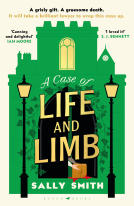
A Shadow on the Lens
by Sam Hurcom
This title was previously available on NetGalley and is now archived.
Send NetGalley books directly to your Kindle or Kindle app
1
To read on a Kindle or Kindle app, please add kindle@netgalley.com as an approved email address to receive files in your Amazon account. Click here for step-by-step instructions.
2
Also find your Kindle email address within your Amazon account, and enter it here.
Pub Date 5 Sep 2019 | Archive Date 10 Jan 2022
Orion Publishing Group | Orion
Talking about this book? Use #AShadowOnTheLens #NetGalley. More hashtag tips!
Description
The Postmaster looked over my shoulder. As I turned to look I saw a flicker of movement from across the street. I felt unseen eyes peer at me.
He walked away without another word. I watched as he climbed onto his bicycle and sped away down the street. I turned back and looked over my shoulder.
Someone had been watching us.
1904. Thomas Bexley, one of the first forensic photographers, is called to the sleepy and remote Welsh village of Dinas Powys, several miles down the coast from the thriving port of Cardiff. A young girl by the name of Betsan Tilny has been found murdered in the woodland - her body bound and horribly burnt. But the crime scene appears to have been staged, and worse still: the locals are reluctant to help.
As the strange case unfolds, Thomas senses a growing presence watching him, and try as he may, the villagers seem intent on keeping their secret. Then one night, in the grip of a fever, he develops the photographic plates from the crime scene in a makeshift darkroom in the cellar of his lodgings. There, he finds a face dimly visible in the photographs; a face hovering around the body of the dead girl - the face of Betsan Tilny.
Available Editions
| EDITION | Other Format |
| ISBN | 9781409189855 |
| PRICE | £14.99 (GBP) |
| PAGES | 288 |
Featured Reviews
This is a terrific debut novel set in the small and insular village of Dinas Powys, South Wales and it’s full of gothic superstition and atmosphere. Thomas Bexley a forensic photographer is sent to investigate the murder of a young girl Betsan Tilny and he meets with much resistance from the villagers who treat him with suspicion and are unwilling to discuss the gruesome murder.
As Thomas becomes more and more frustrated with the lack of support and the hints that something unworldly is possibly responsible for the murder he finds himself seized by fever finding it difficult to know what is real or what is fever induced hallucinations.
This is a book filled with sinister happenings and it really hits the mark for creepiness. I really did enjoy the read it has lots of twists towards the conclusion and it kept me guessing throughout. So if you like a book that’s different with plenty of chills and gothic terror then here you have it.
My thanks to NetGalley and Orion Publishing Group for giving me the chance to read the ARC in exchange for my honest opinion.
 Joseph C, Reviewer
Joseph C, Reviewer
In 1904 forensic photography is in its infancy, but Thomas Bexley is already recognised as one of its foremost exponents. His experience in scene-of-crime examination has also honed his investigative skills such that, despite not being formally an “inspector” (as he will be the first to admit), he has been retained by Scotland Yard as a specialist investigator.
And so it is that on a bright summer’s day in June, he sets off to Dinas Powys, a rural village in South Wales, where he has been asked to assist with an inquiry into the gruesome murder of a young woman, Betsan Tilny. Bexley prides himself in being rational and scientific, with much confidence in his skills. He does not believe in God and still less in talk of spirits, ghosts and suchlike nonsense. So, when the villagers start to blame the quasi-ritual killing on the Calon Farw, the monster supposedly roaming the woodlands around the village, Bexley is quick to dismiss this talk as idle superstition. He is also equally unconvinced by the convenient thesis of Robert Cummings, head of the local council, that the murder has been carried out by an elusive “band of gypsies”.
Bexley’s confidence starts to ebb when he falls prey to strange visions and hallucinations which seriously challenge his certainties. Over the course of a feverish week in June, as he searches for the identity of the murder, he will face horrors human and supernatural: “it marked the change in my life, the death of the man I once was”.
My reactions to the novel were not unlike that of its protagonist. From the blurb, I was expecting a cosy, neo-Victorian murder mystery with a hint of the supernatural, my type of light summer read. With Bexley’s arrival at Dinas Powys, however, things take a decidedly sinister turn and the novel quickly moves into folk horror realm: the investigator is a rational outsider in a superstitious village where a young girl has been brutally murdered, a legendary monster is supposedly lurking in the woods, the inn where Bexley is staying could possibly be haunted and, to boot, the villagers clearly know more than they’re letting on. Bexley was not expecting his investigation to become so complicated – in my case, I did not expect the novel to become so unsettling. Shockingly for a supposed jaded fan of ghost stories, I found myself freaking out during a key scene in the crypt of an abandoned hamlet.
Sam Hurcom has published children’s stories. This is his debut novel, and I would suggest keeping it out of the reach of kids – it’s chilling stuff. I must admit that there were some aspects of the book which did not fully convince me. Thus, whilst the style generally has an “authentic” ring to it, there were some anachronisms here and there, including the use of “Ms.” for “Miss”, in a diary supposedly dating from 1904. One should also not expect much character development – as in much crime fiction, the story is mainly plot-driven.
Ultimately, however, the book delivers. And whilst A Shadow on the Lens is enjoyable as a “historical crime” novel, with plenty of red herrings along the way, what marks it from a crowded market is its unexpectedly dark, folk horror element which is conveyed very effectively. Huron, who was raised, and still lives, in Dinas Powys, claims to be inspired by the landscape of the area. If that’s the case, I would rather not roam there at night.
 Sid R, Reviewer
Sid R, Reviewer
I really enjoyed this book. This debut novel, set in 1904 in Wales, is a very gothic novel and to a certain extent what can be call a supernatural thriller. I'm generally not very fond of that kind of genre but this book had me quite intrigued and interested. But overall what I really enjoyed about this book was it's twists and turns, it's bluffs and double bluffs with red-herrings all throughout the book. I would recommend this book to anyone who has a fondness for creepy, twisty whodunnits. And finally thank you to NetGalley and Orion Publishing Group for giving me this ARC in exchange of my honest review.
Readers who liked this book also liked:
Rick Riordan; Mark Oshiro
Children's Fiction, LGBTQIA, Teens & YA
Keith Martin; Konstantinos Mersinas; Guido Schmitz; Jassim Happa
Business, Leadership, Finance, Computers & Technology, Reference
Vincent B. "Chip" LoCoco
Historical Fiction, Horror, Mystery & Thrillers


















